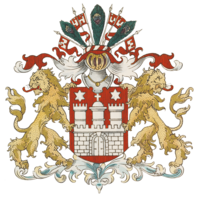Categories Online-Shop Germany German States until 1871 Hamburg
Hamburg

The year 803 is commonly regarded as the founding year of Hamburg, although the earliest detectable mention is the establishment of a diocese by Louis the Pious in 831. A year later, Pope Gregory IV raised the bishopric to the rank of archdiocese. In any case, in the early 9th century Hamburg was a mission center for the conversion of pagan peoples in Northern Germany. In 845 Vikings invaded the settlement and destroyed it. The Archbishop Ansgar (later revered as a saint) fled and the seat of the archdiocese was relocated to Bremen. In the 10th century, Hamburg was plundered several times by the Slavic Abodrites and the reconstruction continued until the 11th century. Several sacred buildings and a defensive fortification were built. However, further raids of Slavic peoples led to Hamburg finally forfeiting its ecclesiastical position.
In 1189 Emperor Frederick I Barbarossa is said to have handed over the charter to the city, which was later "verified" by a fake document from 1267. In any case, the city established a tight network in the course of the 12th and 13th centuries through a lively trade in northern Germany, which ultimately led to the founding of the Hanseatic League. The Hanseatic period brought Hamburg hitherto unknown wealth.
The decline of the Hanseatic League began in the 15th century. The maritime trade lost importance and the territorial princes of the empire disputed Hamburg's privileges. In 1500, Hamburg became part of the Lower Saxony imperial circle in the course of the imperial reform. In 1529, the city confessed to the Protestant denomination. Between 1600 and 1700, the strengthening of the territorial powers continued; and the Hanseatic League became insignificant and Hamburg's star continued to fall, partly because the Scandinavian powers were always throwing covetous gazes on the city. It was not until the 19th century that the importance of the city rose again and it turned from a neutral city-state to an economically strong federal state due to its incorporation into the German Empire in 1871.
In 834/5, Louis the Pious gave the archbishopric the right to mint coins. Pennies after Carolingian model were coined, which however can’t be assigned without a doubt to Hamburg due to the absence of a mint mark. Also imitations of Saxon pennies can be found. In 1255, Hamburg and Lübeck agree on a common currency: the Lübeck-Hamburg mark. Until the Hanseatic period, however, hollow pennies continue to be struck. At this time, however, the first shillings, gold gulden and ducats occur. From the 16th century, the first thalers and the Portugaleser were produced.
|
Product no.: 377341
Hamburg, Free and Hanseatic City, 32 Schilling 1751 IHL Helmeted arms with arabesques, denomination below Rv. Crowned double-headed eagle |
129.00 €
*
Currently unavailable |
|
|
|
|
Product no.: 345750
Hamburg, Free and Hanseatic City, Dreiling 1761 OHK City gate in laurel wreath Rev.:Denomination and date in laurel wreath |
99.00 €
*
In stock |
|
|
|
|
Product no.: 152927
Hamburg, City, 1/4 Reichstaler N.D. (1687) |
Old price 670.00 €
580.00 €
*
In stock |
|
|
|
|
Product no.: 386898
Hamburg, Free and Hanseatic City, 32 Schilling 1758 IHL |
147.00 €
*
In stock |
|
|
|
|
Product no.: 351024
Hamburg, City, Goldgulden N.D. With title Frederick III. St.Peter standing with key and book.
|
|
|
|
|
|
Product no.: 350303
Hamburg, Free and Hanseatic City, Thaler 1735 IHL Helmeted arms dividing IH - L Rv.Crowned double headed eagle, date below |
515.00 €
*
In stock |
|
|
|
|
Product no.: 62561
Hamburg, Free and Hanseatic City, Thaler 1694 City arms in frame, date in box below Rv.Crowned double headed eagle holding sceptre and sword |
460.00 €
*
In stock |
|
|
|









